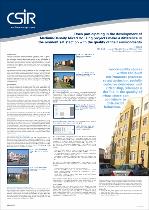 ResearchSpace
ResearchSpace
Does participating in the development of Medium-Density Mixed Housing projects make a difference in the residents’ satisfaction with the quality of their environment?
JavaScript is disabled for your browser. Some features of this site may not work without it.
- ResearchSpace
- →
- Research Publications/Outputs
- →
- Conference Publications
- →
- View Item
| dc.contributor.author |
Sebake, N

|
|
| dc.date.accessioned | 2010-09-02T12:24:27Z | |
| dc.date.available | 2010-09-02T12:24:27Z | |
| dc.date.issued | 2010-09-01 | |
| dc.identifier.citation | Sebake, N. 2010. Does participating in the development of Medium-Density Mixed Housing projects make a difference in the residents’ satisfaction with the quality of their environment?. CSIR 3rd Biennial Conference 2010. Science Real and Relevant. CSIR International Convention Centre, Pretoria, South Africa, 30 August – 01 September 2010, pp 8 | en |
| dc.identifier.uri | http://hdl.handle.net/10204/4315 | |
| dc.description | CSIR 3rd Biennial Conference 2010. Science Real and Relevant. CSIR International Convention Centre, Pretoria, South Africa, 30 August – 01 September 2010 | en |
| dc.description.abstract | CSIR Built Environment has recently completed a multiyear research project, undertaken by Landman et al, that aimed to determine the appropriateness and applicability of medium-density mixed housing (MDMH) developments in South Africa. The research identified and described five critical factors that various stakeholders, including residents, financiers, officials and developers, consider necessary for MDMH to be successful. These critical success factors include affordability, design and layout, safety and security, management and maintenance, and neighbourliness. The premise of this paper is that the quality of the built environment directly influences the people who use it. Good-quality spaces, for example, promote social inclusion, socially cohesive behaviour and citizenship, whereas a decline in the quality of urban space can contribute to anti-social behaviour. The built environment is created by professionals who, in the context of social housing, may never know the users of the buildings they develop. This has created a widening gap between built environment professionals (particularly designers) and end-users, resulting in created environments increasingly failing to meet the needs of users. This paper will use two case studies from the multiyear research project to investigate whether perceptions about the quality of the built environment were affected by the residents’ participation, or lack thereof, at the planning and design stages of the developments | en |
| dc.language.iso | en | en |
| dc.publisher | CSIR | en |
| dc.subject | Medium-density mixed housing | en |
| dc.subject | MDMH | en |
| dc.subject | Mixed housing | en |
| dc.subject | Social housing | en |
| dc.subject | CSIR Conference 2010 | en |
| dc.title | Does participating in the development of Medium-Density Mixed Housing projects make a difference in the residents’ satisfaction with the quality of their environment? | en |
| dc.type | Conference Presentation | en |
| dc.identifier.apacitation | Sebake, N. (2010). Does participating in the development of Medium-Density Mixed Housing projects make a difference in the residents’ satisfaction with the quality of their environment?. CSIR. http://hdl.handle.net/10204/4315 | en_ZA |
| dc.identifier.chicagocitation | Sebake, N. "Does participating in the development of Medium-Density Mixed Housing projects make a difference in the residents’ satisfaction with the quality of their environment?." (2010): http://hdl.handle.net/10204/4315 | en_ZA |
| dc.identifier.vancouvercitation | Sebake N, Does participating in the development of Medium-Density Mixed Housing projects make a difference in the residents’ satisfaction with the quality of their environment?; CSIR; 2010. http://hdl.handle.net/10204/4315 . | en_ZA |
| dc.identifier.ris | TY - Conference Presentation AU - Sebake, N AB - CSIR Built Environment has recently completed a multiyear research project, undertaken by Landman et al, that aimed to determine the appropriateness and applicability of medium-density mixed housing (MDMH) developments in South Africa. The research identified and described five critical factors that various stakeholders, including residents, financiers, officials and developers, consider necessary for MDMH to be successful. These critical success factors include affordability, design and layout, safety and security, management and maintenance, and neighbourliness. The premise of this paper is that the quality of the built environment directly influences the people who use it. Good-quality spaces, for example, promote social inclusion, socially cohesive behaviour and citizenship, whereas a decline in the quality of urban space can contribute to anti-social behaviour. The built environment is created by professionals who, in the context of social housing, may never know the users of the buildings they develop. This has created a widening gap between built environment professionals (particularly designers) and end-users, resulting in created environments increasingly failing to meet the needs of users. This paper will use two case studies from the multiyear research project to investigate whether perceptions about the quality of the built environment were affected by the residents’ participation, or lack thereof, at the planning and design stages of the developments DA - 2010-09-01 DB - ResearchSpace DP - CSIR KW - Medium-density mixed housing KW - MDMH KW - Mixed housing KW - Social housing KW - CSIR Conference 2010 LK - https://researchspace.csir.co.za PY - 2010 T1 - Does participating in the development of Medium-Density Mixed Housing projects make a difference in the residents’ satisfaction with the quality of their environment? TI - Does participating in the development of Medium-Density Mixed Housing projects make a difference in the residents’ satisfaction with the quality of their environment? UR - http://hdl.handle.net/10204/4315 ER - | en_ZA |






